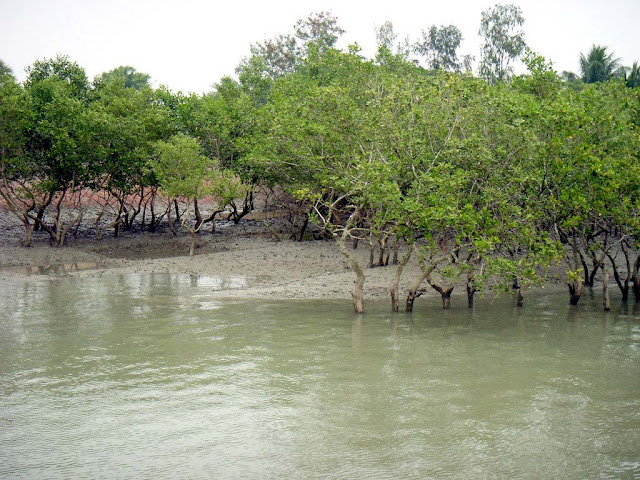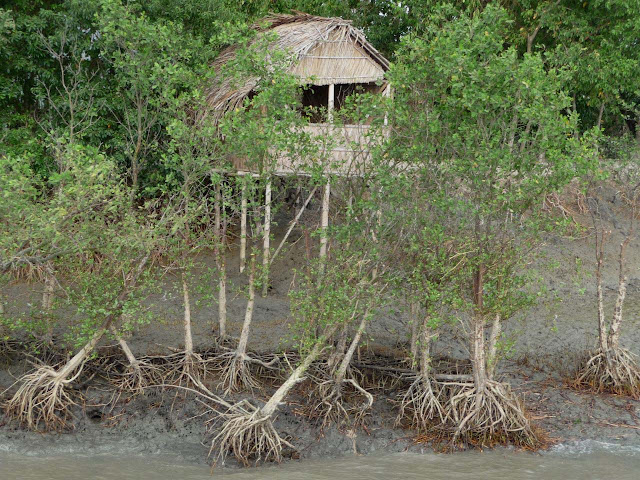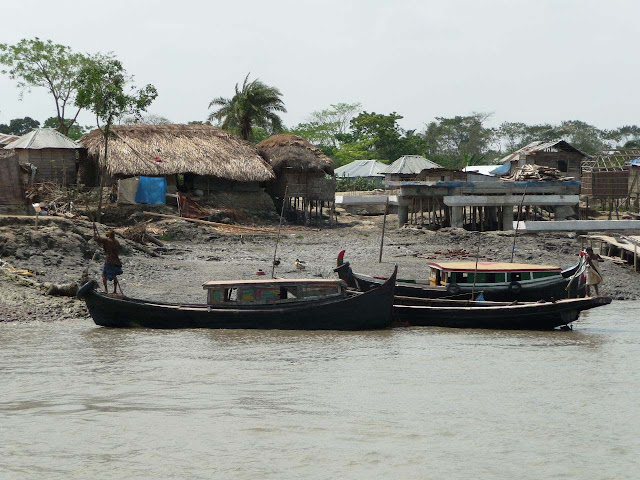The Sundarbans covers 10,000 km2 of land and water (more than half of it in India, the rest in Bangladesh) in the Ganges delta. It contains the world's largest area of mangrove forests. A number of rare or endangered species live in the park, including tigers, aquatic mammals, birds and reptiles.
 |
| Sundarbans |
The site lies south-east of Calcutta in the District of West Bengal and forms part of the Gangetic Delta, which borders on the Bay of Bengal. The Sundarbans, covering some 10,000 km2 of mangrove forest and water, is part of the world's largest delta formed from sediments deposited by three great rivers, the Ganges, Brahmaputra and Meghna, which converge on the Bengal Basin.
The whole Sundarbans area is intersected by an intricate network of interconnecting waterways, of which the larger channels are often a kilometre or two in width and run in a north-south direction. These waterways now carry little freshwater as they are mostly cut off from the Ganges, the outflow of which has shifted from the Hooghly-Bhagirathi channels progressively eastwards since the 17th century. This is due to subsidence of the Bengal Basin and a gradual eastward tilting of the overlying crust. In the Indian Sundarbans, the western portion receives some freshwater through the Bhagirathi-Hooghly river system but that portion designated as the tiger reserve is essentially land-locked, its rivers having become almost completely cut off from the main freshwater sources over the last 600 years. Thus, waterways in the tiger reserve are maintained largely by the diurnal tidal flow, the average rise and fall being about 2.15 m on the coast and up to 5.68 m on Sagar Island.
The land is constantly being changed, moulded and shaped by the action of the tides, with erosion processes more prominent along estuaries and deposition processes along the banks of inner estuarine waterways influenced by the accelerated discharge of silt from seawater. About half of the Sundarbans is under water and the rest of the landscape is characterized by low-lying alluvial islands and mudbanks, with sandy beaches and dunes along the coast.
The entire mangrove forest extends over an area of 4,262 km2 , of which 2,320 km2 is forest and the rest is water, and is called Sundarban owing to the dominance of the tree species Heritiera fomes , locally known as 'sundari'. This marsh vegetation consists of elements of the Malayan Peninsular and Polynesian regions, together with some Indo-Chinese, Ethiopian and a few of the New World. It is not found elsewhere except in a small part of the Mahanadi and Godaveri deltas to the south-west and the Bay Islands.
The Sundarbans is the only remaining habitat in the lower Bengal Basin for a great variety of faunal species. Some of this variety, however, has already been lost owing to the reclamation of the broad transitional belt of habitat for agriculture, combined with the higher salinity resulting partly from the large-scale irrigation schemes in the upper reaches of the Ganges. Species include the Javan rhinoceros and water buffalo, swamp deer and Indian muntjac. Similarly, gharial and narrow-headed softshell turtle became locally extinct within the last 100 years. The tiger population is the largest in India. High population density, relative to the availability of prey, and the relatively high frequency of encounters with local people is probably largely responsible for the notorious man-eating habits of the Sundarbans tiger. The only ungulates are wild boar, main prey species of the tiger, and spotted deer, which is plentiful and often seen in association with rhesus macaque. Aquatic mammals that frequent the tidal waters include the Ganges dolphin, Indo-Pacific humpbacked dolphin, Irrawaddy dolphin and finless porpoise
The Sajnakhali area contains a wealth of waterbirds, noteworthy residents including Asian open-bill stork, black-necked stork, greater adjutant, white ibis, swamp francolin, white-collared kingfisher, black-capped kingfisher and brown-winged kingfisher. This area is important for waders, a rare winter migrant and marsh birds. The Sundarbans provide important habitat for a variety of reptiles.
Baghmara Forest Block contains the ruins of a city built by the Chaand Sandagar merchant community in approximately AD 200-300. Much later, during the Moghul Empire, Raja Basand Rai and his nephew took refuge in the Sundarbans from the advancing armies of Emperor Akbar. The buildings they erected subsequently fell to Portuguese pirates, salt smugglers and dacoits in the 17th century.
Text source:- Wikipedia. Images are copyrighted by their owners. Found any copyright issue, contact the administrator immediately. Report it now!
You have read this article Asia /
Asia Heritage /
Bangladesh /
Heritage /
Heritage India /
Heritage Natural /
India
with the title Sundarbans. You can bookmark this page URL http://tiffanyeatworld.blogspot.com/2011/06/sundarbans.html. Thanks!


































